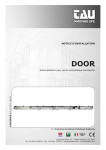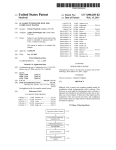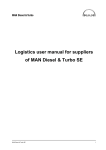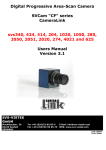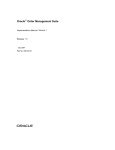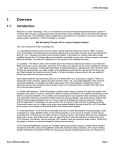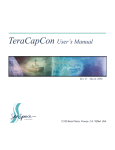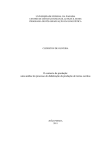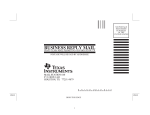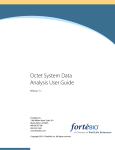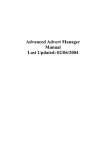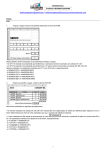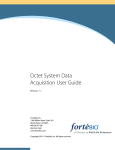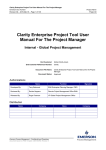Download Main lSetup l Cleanup] Parameters Locals}
Transcript
US008234089B2
(12) United States Patent
(10) Patent No.:
Grey et a].
(54)
(45) Date of Patent:
AUTO-SCHEDULING ()F TESTS
6,112,222 A *
_
_
1/2002
6,397,378 B1
Dalllel ElllaldeAustln, TX (Us)
Assignee: National Instruments Corporation,
Austin TX (Us)
’
( * ) Notice:
11/2000 Alshibaniet a1.
6,336,088 B1
(75) Inventors. James A. ‘Grey, Cedar Park, TX (US),
Jul. 31, 2012
8/2000 Govindaraju et a1. ...... .. 718/102
6,151,022 A *
(73)
US 8,234,089 B2
Bauman et a1.
5/2002 Grey et a1‘
.. 715/788
703/15
“ 7l7/l75
6,502,102 B1 * 12/2002 Haswell et a1.
.. 707/102
6,570,385 B1*
5/2003 Roberts et a1.
.. 324/378
6,697,750 131*
6,708,324 B1*
2/2004 Coin et al
3/2004 So11oWay et a1
.. 702/108
.. 717/124
6,738,813 B1*
5/2004
Subject to any disclaimer, the term of this
patent is extended or adjusted under 35
Reichman ................... .. 709/224
(Continued)
U.S.C. 154(b) by 1024 days.
OTHER PUBLICATIONS
National Instruments Corporation, LabVIEW, “Test Executive Ref
(21)
Appl. No.: 10/289,798
erence Manual,” Aug. 1997.
(22)
Filed;
Executives,”
Johnson, Laura, “Test and MeasurementiUnderstanding Test
N0“ 7, 2002
Webpage
wwwtestandmeasurement.com.content/
neWs/, Oct. 16, 2000, pp. 1-9.
(65)
Prior Publication Data
Us 2004/0093180 A1
_
May 13, 2004
(74) Attorney, Agent, or Firm *Meyertons Hood Kivlin
KoWert & GoetZel, P.C.; Jeffrey C. Hood; Mark S. Williams
(51)
Int. Cl.
G01R 29/00
(52)
US. Cl.
(58)
Field of Classi?cation Search ................ .. 702/108,
(2006.01)
(57)
...................................... .. 702/123; 702/119
702/117,118,119,121,123,182
See application ?le for complete search history.
(56)
U.S. PATENT DOCUMENTS
>D
ABSTRACT
.
10/1982 Hays et a1. .................. .. 710/240
8/1986 Hough
710/200
11/1993 Saxon
718/106
4/1995 Miller .... ..
718/104
6/1996 Kolb etal.
.. 701/29
8/1996 Giordano et a1.
.. 714/26
11/1998 Rand .......... ..
379/9
1/1999 Fitting .......... ..
707/200
4/1999 Greenspan et a1. ......... .. 711/150
12/1999 Jenkins et a1. .............. .. 717/105
2/2000 O’Donnell et a1. ........... .. 714/40
resource of a plurality of resources . A ?rst test is performed on
resource, Where the second resource is not currently being
used. If the second test is found, the second test is performed
on the unit, or a second unit, using the second resource,
substantially concurrently With at least a portion of the ?rst
test being performed on the unit. Performing a test includes
locking the respective resource to exclude use by other tests,
including acquiring the resource, and unlocking the resource
upon completion of the test, including releasing the resource
for use in performing the respective test on another of the
units.
36 Claims, 9 Drawing Sheets
5 E Sequenc File3 *
Main lSetup l Cleanup] Parameters Locals}
E 1 Step
l? Description
'
" i
i
@Begin Auto-Schedule
Begin Auto-Schedule
@035 1
Numeric Limit Test, 0 <: x <= 10
J
....... ._
ij Unlock Resource
I
.
__ w
Unlock Resource
{7} Lock Resource
Lock: "Scope"
it
@Test 2
Numeric Limit Test, 0 =:= x <= 10
E
1
‘
ii Unlock Resource
El Lock Resource
@Test 3
Unlock Resource
Lock: "Camera"
i’
Unlock Resource
Unlock Resource
;,
'1
End Auto-Schedule
END
Encl Auto-Schedule
a
.
S ys temand methO dfOrperfOnmngamu 1t1p 1 e tes t Soneac h O f
one or more units, Where each of the tests requires a respective
a unit using a ?rst resource. During performance of the ?rst
test, a search is made for a second test, requiring a second
References Cited
4,354,227
4,604,694
5,261,097
5,408,663
5,524,078
5,544,308
5,838,766
5,857,192
5,893,157
6,002,868
6,023,773
_
Primary Exammer * Jeffrey R West
Numeric Limit TestJ 0 <= x <= 10
-.
US 8,234,089 B2
Page 2
US. PATENT DOCUMENTS
6,738,974 B1 *
6,842,022 B2 *
5/2004
Nageswaran et a1. ....... .. 718/104
1/2005
Khoche ............ ..
. 324/754
2001/0044913 A1* 11/2001 Brassac et a1.
714/33
2002/0124205 A1* 9/2002 Grey et a1. .................... .. 714/33
2003/0093524
2003/0120825
2003/0160826
2003/0212523
A1* 5/2003 Goldick ...................... .. 709/225
A1* 6/2003 Avvari et a1
709/316
A1* 8/2003 Tran et a1 .
345/771
A1* 11/2003 Dorough et a1. ............ .. 702/119
* cited by examiner
US. Patent
Jul. 31, 2012
Sheet 1 019
US 8,234,089 B2
T5 Sequence File3 *
Main } Setup ] Cleanup I Parameters } Local: I
Step
1 Description
£1 Lock DMM
Lock("DMM")
@Test 1
Numeric Lin'iit Test, 0 <= >< <= 10
Q) Unlock DMM
Q] Lock Scope
EarlyUnlock("DMM")
Lock("Scope")
@Tesl: 2
Numeric Limit Test, 0 <= x <= 10
[5?] Unlock Scope
[g Lock Camera
Lock("Scope")
Lock("Camera")
?ii'eééjij.ITTITIII‘I i;.. . ;.;...;;.j .i
[{2} Unlock Camera
..
EarlyLIn|ock["Carnera")
END
Fig. 1A (Prior Art)
Fig. 18 (Prior An‘)
US. Patent
Jul. 31, 2012
Sheet 2 of9
US 8,234,089 B2
A,‘
‘CMontiroln
36
1
US. Patent
Jul. 31, 2012
Sheet 7 0f 9
US 8,234,089 B2
I" E Sequence File3 *
Mal-n a 1 Setup } Cleanup] Parameters l- Locals]
ll Description
| Step
<3
ii éwck
Beg".Res.
?wfqzsEhedsle....
mega";
Begin Auto-Schedule
....L.é'.l""=".'"DM.Mf'.....T1I'1" "
Numeric Limlt Test, 0 <= x <= 10
Unlock Resource
Unlock Resource
Lock: "Scope"
a Lock Resource
@Test 2
Numeric Limit Test, U <= >( €= 1U
13E Unlock Resource
if} Lock Resource
Unlock Resource
Unlock Resource
Unlock Resource
End Auto-Schedule
End Auto-Schedule
Lock: "Camera"
Numeric Limlt Test, 0 <= x <= 10
>
END
Fig.
;
7A
Fig. 7B
'i .'
US. Patent
Jul. 31, 2012
Sheet 8 of9
US 8,234,089 B2
Per Execution Thread
329
search plurality of tests for next test to perform
V
on unit
lock resource
@
l
perform test on unit
BLB
unlock resource
mu
YES
NO
Fig. 8
”
US. Patent
Jul. 31, 2012
Sheet 9 of9
‘ Step
US 8,234,089 B2
I Descrlption
}
Begin A
END
Add Auto-Scheduled Section Etr|+E K
51.
Set
Specify.
Auto-Schedule
F'hJduIe. . . Timeout... CtnHM'
Fig. 9A
Haio
Cleenup‘Pararneters tooelei
Step
5
Description
E3’) Begin Auto-Schedule
Begin Auto-Schedule
? LockResource
5%; Insert your steps here...
Not Con?gured
it UnlockResource
Unlock Resource
§§EndAutoSchedule
End Auto-Schedule
END
Fig. 9B
’;
'
US 8,234,089 B2
1
2
AUTO-SCHEDULING OF TESTS
Thus, the user may use the sequence editor to construct a
test executive sequence comprising a plurality of steps. The
test executive sequence may then be executed to perform tests
FIELD OF THE INVENTION
of a system or UUT.
In some systems, multiple UUTs may be tested in parallel.
The present invention relates to the ?eld of test executive
This approach generally increases the testing system perfor
software for organizing and executing test executive
mance since it allows multiple units to be tested at the same
sequences. In particular, the invention relates to a system and
method for e?icient execution of multiple tests on one or
time. For example, a plurality of tests may be performed on
each of a plurality of UUTs, where each test may require
more units.
exclusive use of one or more resources, e.g., oscilloscope,
sensor, digital multi-meter (DMM), etc., during execution of
the test, e.g., by using respective execution threads to test
DESCRIPTION OF THE RELATED ART
respective units in parallel. However, when performing par
Test executive software is specialized software that allows
allel testing, ine?iciencies may result when executing threads
a user to organize and execute sequences of reusable test
must wait for a speci?c resource or resources to be released.
FIGS. 1A and 1B illustrate a prior art approach to parallel
modules to test units under test (UUTs). For example, the test
modules may interact with one or more hardware instruments
to test the UUT(s). The test modules often have a standard
interface and typically can be created in a variety of program
ming environments. The test executive software operates as a
20
control center for the automated test system. More speci?
cally, the test executive software allows the user to create,
con?gure, and/ or control test sequence execution for various
test applications, such as production and manufacturing test
applications. Text executive software typically includes vari
test scheduling, where three tests are performed on four
UUTs. FIG. 1A illustrates a test step sequence where a ?rst
test, Test 1, requires use of a DMM, a second test, Test 2,
requires use of an oscilloscope, and a third test, Test 3,
requires use of a camera. As is well-known in the art, when a
resource is used exclusively for a test, the resource is typically
locked prior to the test execution, then released after the test
execution. Thus, in the test sequence shown in FIG. 1A, the
sequence contains the necessary synchronization steps to
25 ensure that no two threads access the same resource at the
ous features, such as test sequencing based on pass/ fail
same time. Protecting the test step with locks is needed to
results, logging of test results, and report generation, among
avoid collisions, i.e., simultaneous requests for resources,
others.
since there is only one instance of each resource (e. g., DMM,
Test executives include various general concepts. The fol
lowing comprises a glossary of test executive nomenclature,
oscilloscope, camera) and the resources will be shared (se
quentially) by all the UUTs being tested in parallel. Thus, as
FIG. 1A shows, for a given UUT, the DMM is ?rst locked,
then Test 1 is performed. Once Test 1 is complete, the DMM
is unlocked. The test sequence then locks the oscilloscope
(“scope”), performs Test 2 on the UUT, and upon completion
of Test 2 unlocks the oscilloscope, as shown. Finally, the
30
as used herein:
Code ModuleiA program module, such as a Windows
Dynamic Link Library (.dll), LabVIEW VI (.vi), ActiveX
component, or other type of program module or component,
that implements one or more functions that perform a speci?c
35
test or other action.
Test ModuleiA code module that performs a test of a
UUT.
StepiAn action that the user can include within a
sequence of other actions. A step may call a test module to
perform a speci?c test.
Step ModuleiThe code module that a step calls.
SequenceiA series of steps that the user speci?es for
execution in a particular order. Whether and when a step is
executed can depend on the results of previous steps.
40
45
Sequence FileiA ?le that contains the de?nition of one or
becomes available, UUT 2 can start the testing process, leav
ing UUT 3 and UUT 4 still idle. As Test 1 is completed for
50
?rst portion of the testing and the last portion of the testing. In
other words, in the table of FIG. 1B, any time during the test
55
Application Development Environment (ADE)iA pro
multiple tests are to be performed on a single UUT, simple
linear performance of the tests may result in substantial
resource idle time.
60
which the user can create test modules and run-time operator
being tested.
Thus, it would be desirable to provide improved systems
and methods for performing parallel testing on one or more
units under test.
gramming environment such as LabVIEW, LabWindows/
CVI, Microsoft Visual C++, Microsoft Visual Basic, etc., in
interfaces.
Unit Under Test (UUT)iThe device or component that is
procedure that the UUTs are not being tested represents an
ine?iciency, i.e., wasted time. Similarly, in situations where
Test Executive EngineiA module or set of modules that
provide an API for creating, editing, executing, and debug
ging sequences. A sequence editor or run-time execution
operator interface uses the services of a test executive engine.
each UUT, the resources for Test 1 are freed for use in per
forming Test 1 on the next UUT. This staggered sequencing is
performed for each of the tests, leading to idle resources in the
graphical user interface for executing sequences on a produc
tion station. A sequence editor and run-time operator inter
face can be separate application programs or different aspects
of the same program.
when UUT1 is performing Test 1 (and using the associated
resources), the other units are held idle, waiting for the
resource to become available. When the resource for Test 1
more sequences.
Sequence EditoriA program that provides a graphical
user interface for creating, editing, and debugging sequences.
Run-time Operator InterfaceiA program that provides a
camera is locked, Test 3 is performed on the UUT, and the
camera is unlocked, after which the test sequence for that
UUT is terminated.
FIG. 1B is a table illustrating execution ?ow of testing 4
UUTs in parallel using the test sequence of FIG. 1A. As FIG.
1B shows, the test sequence is applied to each UUT in a
staggered fashion to prevent resource request con?icts. How
ever, a problem with this approach is that there are some idle
hardware times. As may be seen, at the beginning of the test,
SUMMARY OF THE INVENTION
65
Various embodiments of a system and method for perform
ing a plurality of tests on each of one or more units under test
US 8,234,089 B2
3
4
(UUT) are presented, Where each of the plurality of tests
performing, and unlocking may be performed by the execu
requires or is associated With a respective resource of a plu
rality of resources. The plurality of tests may be speci?ed in a
test sequence, also referred to as an auto-scheduled test
tion thread until 1) each of the plurality of tests has been
performed on the unit, and/or 2) an ending condition is met.
Considering all of the execution threads together, the search
sequence, described beloW. A plurality of execution threads
ing, locking, performing, and unlocking may be performed
may be used to perform at least a portion of tWo or more of the
(by the various execution threads) until 1) each of the plurality
tests substantially in parallel. In an embodiment Where the
plurality of tests are to be performed on each of a plurality of
of tests has been performed, e.g., on each of the plurality of
units, and/or 2) the ending condition is met. The ending
condition may include time-outs, equipment failure, manual
units, a thread may be associated With each unit. In an
embodiment Where the plurality of tests is to be performed on
a single unit, each thread may be associated With one or more
of the tests, or may simply perform any of the tests as each is
able. The threads may in effect compete for use of the
resources to perform respective tests on the unit or units by
each performing an embodiment of the method described
or automatic termination of the test process, and/or any other
type of ending condition.
Once the resource associated With the test has been
unlocked, the method may further include searching for
another, i.e., a different, test of the plurality of tests to be
performed on the respective unit, Where 1) the different test
requires another, i.e., a different, resource of the plurality of
resources, and 2) the different resource is not currently being
beloW.
It is noted that a test may be a single operation, or may be
tWo or more operations or subtests. In other Words, a “test”
multiple devices or components (or programs). Thus, When a
used. If the different test is found, then the method may
perform the different test on the respective unit using the
different resource, Where performing the different test on the
test is performed on a unit using a resource, it may be that
respective unit is performed substantially concurrently With
multiple subtests (i.e., tests) are performed on the unit (or a
component of the unit) using a plurality of devices. It should
be noted that in other embodiments, described beloW, the
performing the respective test on the different one of the
may actually refer to multiple tests. Similarly, a resource may
be a single device or component (or program), or may include
20
25
methodmay be performed by a plurality of threads to perform
a plurality of tests on a single unit.
In one embodiment, the plurality of tests may be searched
for a next test to perform on the unit, Where 1) the test has not
been performed on the unit, and 2) the respective resource of
30
the test is available for use. In other Words, an attempt may be
made to determine a test Whose associated resource is not
at least a portion of tWo or more of the tests are performed
same test on another unit. If the test is not found, the method
35
perform a particular test on the UUT. Thus, in one embodi
ment, if there are three tests to be performed on the unit, three
40
tests, but rather tWo or more threads may operate to perform
three or more tests betWeen them.
once a free resource for a desired test is determined, the
45
50
tiple execution threads may operate substantially in parallel,
performing respective tests, e.g., on associated UUTs, as the
respective resources become available. In other Words, tWo or
more of the respective tests on the respective units may be
Thus, similar to the method described above, in one
embodiment, the method may include searching the plurality
resource may be used to perform the associated test on the
UUT.
Once the test has been performed, the respective resource
may be unlocked, thereby releasing the resource for use by
other tests/threads. As noted above, in one embodiment, mul
threads may be launched, Where each thread is capable of
performing any of the three tests on the unit. In other embodi
ments, the number of threads may not equal the number of
met. If the respective test is found, then the respective
resource of the respective test may be locked, Where locking
includes acquiring the respective resource. In other Words,
method may lock the resource, thereby excluding use of the
resource by execution threads for other tests. The respective
test may then be performed on the unit, e.g., the locked
substantially concurrently. In this embodiment, multiple
execution threads may be launched, Where each thread may
perform an embodiment of the above method in order to
then the method may continue searching. In other Words, if
the respective test for the respective unit is not found, the
method may continue the searching until the respective test is
found, or an ending condition, e.g., a time-out condition, is
The general concepts presented above may also be applied
to performing multiple tests on a single unit. In other Words,
the method may perform multiple tests on a single unit, Where
currently being used to perform another test, or to perform the
may check against a time-out condition, and if a time-out has
occurred, the method may exit. If no time-out has occurred,
plurality of units. In other Words, once the respective test has
been performed on the respective unit, e. g., by a ?rst thread,
not only may the method ?nd and perform another test on the
respective unit, but the method may also ?nd and perform the
respective test on another unit, assuming that the respective
test has not yet been performed on the other unit.
55
of tests to determine a respective test, Where the respective
test has not been performed on the unit, and Where the respec
tive resource of the respective test is available for use. If the
respective test is found, the respective resource of the respec
tive test may be locked (acquired), and the respective test
performed on the unit. The respective resource of the respec
tive test may then be unlocked (released). In a preferred
embodiment, at least portions of the searching, locking, per
forming, and unlocking for a plurality of the respective tests
performed substantially concurrently, e. g., by respective
may be performed substantially concurrently. The searching,
locking, performing, and unlocking may be performed itera
execution threads. In another embodiment, at least portions of
tively until each of the plurality of tests has been performed on
the searching, locking, performing, and unlocking for a plu
rality of the respective tests may be performed substantially
the unit, or until a stopping condition is met, e.g., due to
60
concurrently.
embodiments of the method may be used to perform a plu
rality of tests on a single unit.
It should be noted that in other embodiments, the tWo
After the respective resource has been unlocked, an ending
condition may be checked, and if the ending condition is met
the method may exit, otherwise, the method may proceed
searching for another test to perform on the unit, as described
above. In one embodiment, searching for the next test may be
performed iteratively. For example, the searching, locking,
hardWare problems, manual termination, etc. Thus, various
65
approaches described above may be combined. In other
Words, multiple threads may be used to perform a plurality of
tests on each of a plurality of units, Where at least a portion of
the tests are performed in substantially parallel fashion, and in
US 8,234,089 B2
5
6
doing so, multiple tests may be performed (by multiple
Auto-Scheduled Section” option. Thus, in one embodiment,
threads) on a respective unit in a substantially concurrent
for ease of use, the GUI may automatically insert additional
steps that are needed.
In one embodiment, a “Begin Auto-Schedule” step and a
manner.
In some situations, the above described methods may result
in thread “starvation”, Where various factors such as process
ing bias and/or circumstance may prevent or exclude a thread
from acquiring a resource to perform a test. In other Words,
because each of the threads are effectively competing for test
resources, in some cases a particular thread may be prevented
from ever (or at least for a relatively long time, e.g., before a
time-out condition occurs) acquiring a resource. Thus, in an
corresponding “END” step may be generated, e.g., in
response to user input received by the GUI. Once the begin/
end steps of the auto-schedule block have been added to the
test sequence ?le, the user may select another menu option
indicating the addition of an auto-scheduled section, resulting
in insertion of an auto-scheduled section (possibly including
a “Lock Resource” and an “Unlock Resource” step) as Well as
an “End Auto-Schedule” step. In one embodiment, a label
may also be added that shoWs Where the user-de?ned or
embodiment of the method Where the searching, locking,
performing, and unlocking are performed by a respective
execution thread, each of the plurality of resources may be
associated With it a respective queue structure or its equiva
speci?ed test steps must be added for each auto-scheduled
lent, e. g., a FIFO (?rst in, ?rst out), for storing threads Waiting
for the respective resource. In this case, searching the plural
the addition of an auto-schedule section, the GUI may pro
ity of tests to determine a respective test may include each
thread examining the plurality of resources to determine a
free resource (i.e., unlocked), and if a free resource is found,
section. Thus, in response to receiving user input indicating
grammatically insert one or more steps in the test sequence
20
cation. For example, if an application requires locking three
determining the respective test associated With the free
resource. If no free resource is found, the method may deter
mine a resource of the plurality of resources With feWest
threads in the FIFO for that resource, and add the thread to the
FIFO for that resource. In one embodiment, When the respec
tive resource is acquired, i.e., When the execution thread locks
the resource, the thread may be removed from any other
FIFOs storing the thread. In other Words, once the thread
successfully ?nds a free resource, the thread may be removed
25
“Lock Resource” step and selecting a “Con?gure Lock
Resource . . . ” option or its equivalent. A pop-up dialog may
be displayed and the user may provide input, e.g., a string,
30
35
provided in the form of a stand-alone application, a dynamic
linked library, and/ or a plug-in program module for an exist
sets of instruments, then three auto-scheduled sections may
be inserted.
Once an auto-scheduled section has been inserted, the
resource (or group of resources) that section Will utiliZe may
be con?gured, e.g., by right clicking on the corresponding
from any FIFOs in Which the thread is still Waiting.
While in many embodiments, the auto-scheduled test
sequences described above may be generated manually by a
user, it may be desirable to provide means for more easily
generating auto-scheduled test sequences. Thus, in one
embodiment, program instructions implementing a tool or
interface for generating auto-schedule test sequences may be
for specifying a respective test to be performed. This opera
tion may be repeated as many times as needed for each appli
40
ing application, such as, for example, National Instruments
TestStand product. In another embodiment, the program
instructions may simply be integrated into an existing pro
gram, thereby extending the functionality of the program to
indicating the name of the resource to lock, or a selection from
a list of available resources. If the section utiliZes more than
one resource, an array of strings may be entered, Where each
string contains the name of the resource to lock. The “Lock
Resource” step may automatically create a Lock for each of
the names indicated, i.e., manual creation of the locks may not
be required. In one embodiment, if a Lock for an indicated
resource (name) already exists, the “Lock Resource” step
type may connect to the existing Lock. Thus, in a preferred
embodiment, further user input may be received by the GUI
block and the one or more auto-scheduled sections. In other
specifying the resource and the desired steps needed to per
form the respective test using that resource, e.g., by an “Insert
Step” menu option. The user may thus add and specify suc
cessive auto-schedule sections for the auto-schedule block,
Where each section indicates or performs a respective test
using a respective resource.
As mentioned above, in one embodiment, the auto-sched
uled step types may include a timeout feature, thus, in addi
tion to specifying the auto-schedule sections, an option may
be presented to the user for specifying a time-out condition
for the auto-schedule block. In one embodiment, the speci?ed
timeout may be applied to all of the auto-scheduled sections.
Words, in one embodiment, a test sequence may be created in
response to user input, Where creating the test sequence
In other Words, the auto-scheduled steps may be vieWed as a
group or block that performs a particular function, e.g., a test
include the desired features.
45
In a preferred embodiment, for a test sequence to be per
formed in auto-scheduled mode, at least one auto-scheduled
block plus one or more auto-scheduled sections may be
included. Thus, in one embodiment, a graphical user interface
(GUI) may present menu options to the user for creating,
50
modifying, and otherWise specifying the auto-scheduled
includes receiving user input requesting an automatic sched
uling feature, and programmatically creating one or more
steps in the test sequence to enable the automatic scheduling
55
feature. The one or more steps may include at least one
auto-schedule block, including a plurality of auto-scheduled
sections, each specifying a respective test of the plurality of
suite, and thus, in this embodiment, the timeout may be
de?ned at the top level and may be applied to every auto
scheduled section inside the auto-schedule block. If an auto
scheduled block times-out, it indicates that one of the auto
scheduled sections Was not able to acquire its resources
60
Within the speci?ed time. In one embodiment of the GUI, a
timeout may be set by right clicking on the “Begin Auto
Scheduled” step and selecting the option “Set Auto-Schedule
tests and a respective resource of the plurality of resources for
use in performing the respective test.
In one embodiment, When creating a sequence, the user
Timeout . . . ”. A pop-up dialog may be displayed presenting
may simply insert a “Begin Auto-Schedule” step. This step
the option to enable or disable the timeout for the current
block. In one embodiment, the GUI may also alloW the user to
may include con?guration menus that alloW the user to add
auto-scheduled sections and/or a timeout, e. g., by right click
ing on the “Begin Auto-Schedule” step and selecting an “Add
65
specify Whether a timeout causes a runtime error or simply
terminates.
US 8,234,089 B2
8
7
It should be noted that the above approach may be used to
FIG. 4 illustrates a test executive application softWare
architecture according to one embodiment of the present
generate additional auto-schedule blocks, With respective
auto-schedule sections, time-out speci?cations, etc.
Although the above described embodiment is implemented
invention;
as a set of steps organized into an auto-schedule block, other
FIG. 5 illustrates one example of a test executive sequence,
created according to one embodiment of a test executive
approaches are also contemplated. For example, the plurality
application;
FIG. 6 illustrates an exemplary dialog box for a test execu
of tests may be included in a selection structure, such as a case
tive step, Which enables the user to specify various properties
for the step that affect the Way the test executive softWare
manages the execution of the step;
FIGS. 7A and 7B illustrate scheduling and execution How
statement, as is Well-knoWn in the art. This type of selection
structure may be implemented in a variety of Ways, including,
but not limited to, graphical programming languages such as
National Instruments “G” language, used in the LabVIEW
graphical program development environment, and text-based
of test executive sequences for one or more units under test in
programming languages, such as C, C++, etc.
parallel, according to one embodiment;
In an embodiment Where the selection structure is a case
FIG. 8 is a ?owchart diagram illustrating one embodiment
statement, each of the plurality of auto-scheduled sections
of a method for performing test executive sequences on one or
may comprise or may be included as a respective case in the
case statement. In one embodiment, each respective case may
more units under test in parallel; and
FIGS. 9A and 9B illustrate creation of an auto-schedule
test sequence using a graphical user interface, according to
be selectable based on a label indicating the respective
resource, Where the respective resource is not currently in use.
In another embodiment, the label for each case may indicate
20 one embodiment.
the test instead of the resource, Where the associated resource
is implied by the test. The locking and/or unlocking function
ality for resource management may be performed by case
speci?c code inside each respective case section, or alterna
tively, by implicit program instructions connected or
associated With the case. Additionally, other functionality
25
required by the testing process may also be provided by
explicit or implicit code.
For example, in one embodiment of the auto-schedule case
statement, there may be no explicit selection variable used to
select the case, i.e., to match With the case label. Rather, an
“auto-schedule” block indicator at the beginning of the case
statement may have associated code that manages an iterative
30
process Whereby each case is considered based on resource
35
DETAILED DESCRIPTION OF THE PREFERRED
EMBODIMENTS
Incorporation by Reference
40
Alternatively, explicit code may be provided for the above
described functionality. For example, the case statement may
be embedded in a loop for iterative consideration of each
case/test. As another example, an explicit function may be
provided that determines the next test to be performed.
Thus, in various embodiments, auto-schedule test
Executive System and Method Including Step Types for
Improved Con?gurability,” ?led Feb. 26, 1999.
The LabVIEW and BridgeVIEW graphical programming
manuals, including the “G Programming Reference Manual”,
available from National Instruments Corporation, are hereby
incorporated by reference in their entirety.
45
The TestStand user manual, available from National Instru
ments Corporation, is also hereby incorporated by reference
in its entirety.
FIG. 2iInstrumentation System
sequences may be created that substantially improve ef?cien
cies of test procedures by reducing testing resource idle time.
Additionally, the auto-schedule test sequences may be gen
erated via a GUI, Where the GUI programmatically inserts
steps and/or structures into the test sequence in response to
user input.
The folloWing references are hereby incorporated by ref
erence in their entirety as though fully and completely set
forth herein.
US. patent application Ser. No. 09/259,162 titled “Test
availability and Whether the case, i.e., the test, has already
been performed on the unit. In one embodiment, each “case”,
e.g., case “Camera”, may have associated code that deter
mines the availability of the respective resource and/ or keeps
track of Whether the test has already been performed on the
unit.
While the invention is susceptible to various modi?cations
and alternative forms, speci?c embodiments thereof are
shoWn by Way of example in the draWings and are herein
described in detail. It should be understood, hoWever, that the
draWings and detailed description thereto are not intended to
limit the invention to the particular form disclosed, but on the
contrary, the intention is to cover all modi?cations, equiva
lents and alternatives falling Within the spirit and scope of the
present invention as de?ned by the appended claims.
50
FIG. 2 illustrates an exemplary instrumentation control
system 100. The system 100 comprises a host computer 102
that connects to one or more instruments. The host computer
102 comprises a CPU, a display screen, memory, and one or
more input devices such as a mouse or keyboard as shoWn.
The computer 102 may connect through the one or more
BRIEF DESCRIPTION OF THE DRAWINGS
55 instruments to analyZe, measure or control one or more units
under test (UUT) or processes 150, here represented by UUT
150A and UUT 150B. It is noted that FIG. 2 is exemplary
only, and the present invention may be used in conjunction
A better understanding of the present invention can be
obtained When the folloWing detailed description of the pre
ferred embodiment is considered in conjunction With the
folloWing draWings, in Which:
60
With any of various systems, as desired.
In one embodiment, the UUT may be a system comprising
a plurality of sub-components, Where respective tests are to be
FIGS. 1A and 1B illustrate scheduling and execution How
of test executive sequences for multiple units under test in
performed on each component. The computer 102 may
parallel, according to the prior art;
execute a test executive sequence to perform automated tests
FIG. 2 illustrates an instrumentation control system
according to one embodiment of the present invention;
FIG. 3 is a block diagram of the computer system of
FIG. 2;
65
of the system or portions of the system. As described beloW,
the computer 102 may launch multiple execution threads to
perform a plurality of tests, some of Which may be performed
substantially in parallel.
US 8,234,089 B2
10
located in a second different computer that connects to the
?rst computer over a netWork, such as the Internet. In the
The one or more instruments may include a GPIB instru
ment 112 and associated GPIB interface card 122, a data
acquisition board 114 and associated signal conditioning cir
latter instance, the second computer may provide program
cuitry 124, a VXI instrument 116, a PXI instrument 118, a
instructions to the ?rst computer for execution. The host
computer CPU executing code and data from the memory
medium may comprise a means for implementing the meth
ods described beloW.
video device 132 and associated image acquisition card 134,
a motion control device 136 and associated motion control
interface card 138, and/ or one or more computerbased instru
FIG. 34Computer System Block Diagram
ment cards 142, among other types of devices.
The GPIB instrument 112 may be coupled to the computer
102 via a GPIB interface card 122 provided by the computer
FIG. 3 is a block diagram of the computer system illus
trated in FIG. 2. It is noted that any type of computer system
con?guration or architecture can be used as desired, and FIG.
3 illustrates a representative PC embodiment. It is also noted
102. In a similar manner, the video device 132 may be
coupled to the computer 102 via the image acquisition card
134, and the motion control device 136 may be coupled to the
computer 102 through the motion control interface card 138.
The data acquisition board 114 may be coupled to the com
that the computer system may be a general purpose computer
system as shoWn in FIG. 2, a computer implemented on aVXI
card installed in a VXI chassis, a computer implemented on a
PXI card installed in a PXI chassis, or other types of embodi
ments. Elements of a computer not necessary to understand
puter 102, and optionally interfaces through signal condition
ing circuitry 124 to the UUT. The signal conditioning cir
cuitry 124 preferably comprises an SCXI (Signal
the present invention have been omitted for simplicity.
The computer 102 includes at least one central processing
Conditioning eXtensions for Instrumentation) chassis com
prising one or more SCXI modules 126.
20
unit or CPU 160 that is coupled to a processor or host bus 162.
The GPIB card 122, the image acquisition card 134, the
The CPU 160 may be any of various types, including an x86
motion control interface card 138, and the DAQ card 114 are
typically plugged in to an I/O slot in the computer 102, such
processor, e.g., a Pentium class, a PoWerPC processor, a CPU
as a PCI bus slot, a PC Card slot, or an ISA, EISA or Micro
Channel bus slot provided by the computer 102. HoWever,
25
these cards 122, 134, 138 and 114 are shoWn external to
computer 102 for illustrative purposes. The cards 122, 134,
138 and 114 may also be implemented as external devices
coupled to the computer 102, such as through a serial bus.
The VXI chassis or instrument 116 may be coupled to the
30
ing system softWare as Well as other softWare for operation of
the computer system, as Well known to those skilled in the art.
The host bus 162 is coupled to an expansion or input/output
bus 170 by means of a bus controller 168 or bus bridge logic.
computer 102 via a serial bus, MXI bus, or other serial or
parallel bus provided by the computer 102. The computer 102
preferably includes VXI interface logic, such as a VXI, MXI
or GPIB interface card (not shoWn), Which interfaces to the
VXI chassis 116. The PXI chassis or instrument is preferably
35
The expansion bus 170 is preferably the PCI (Peripheral
40
types can be used. The expansion bus 170 includes slots for
various devices such as the data acquisition board 114 (of
FIG. 2) and a GPIB interface card 122 that provides a GPIB
bus interface to the GPIB instrument 112 (of FIG. 2). The
Component Interconnect) expansion bus, although other bus
coupled to the computer 102 through the computer’s PCI bus.
A serial instrument (not shoWn) may also be coupled to the
computer 102 through a serial port, such as an RS-232 port,
USB (Universal Serial bus) or IEEE 1394 or 1394.2 bus,
provided by the computer 102. In typical systems an instru
from the SPARC family of RISC processors, as Well as others.
Main memory 166 is coupled to the host bus 162 by means of
memory controller 164.
The main memory 166 may store softWare according to one
embodiment of the present invention, such as test executive
softWare With functionality as described above With reference
to FIG. 2, and as described in detail beloW With reference to
FIGS. 7A-9B. The main memory 166 may also store operat
ment Will not be present of each interface type, and in fact
computer 102 further comprises a video display subsystem
many systems may only have one or more instruments of a
180 and hard drive 182 coupled to the expansion bus 170.
As shoWn, a recon?gurable instrument 190 may also be
connected to the computer 102. The recon?gurable instru
single interface type, such as only GPIB instruments.
The instruments are coupled to the unit under test (UUT) or
process 150, or are coupled to receive ?eld signals, typically
generated by transducers. Other types of instruments or
devices may be connected to the system, as desired.
The computer system 102 may include a memory medium
on Which test executive softWare according to one embodi
ment of the present invention is stored. The test executive
softWare may alloW a user to create, con?gure, and/or control
test executive sequence execution for various test applica
45
con?gurable logic, such as a programmable logic device
(PLD), e. g., an FPGA, or a processor and memory, Which may
execute a real time operating system. Program instructions
may be doWnloaded and executed on the recon?gurable
50
functional unit may be comprised on an instrument or device
connected to the computer through means other than an
55
expansion slot, e.g., the instrument or device may be con
nected via an IEEE 1394 bus, USB, or other type of port. Also,
the functional unit may be comprised on a device such as the
data acquisition board 114 or another device shoWn in FIG. 2.
60
Test Executive SoftWare Components
FIG. 4 is a block diagram illustrating high-level architec
tural relationships betWeen elements of one embodiment of a
test executive softWare application. It is noted that FIG. 4 is
exemplary, and the present invention may be utiliZed in con
junction With any of various test executive softWare applica
etc.; or a non-volatile memory such as a magnetic media, e.g.,
a hard drive, or optical storage. The memory medium may
comprise other types of memory as Well, or combinations
thereof. In addition, the memory medium may be located in a
?rst computer in Which the programs are executed, or may be
instrument 190. In one embodiment, at least a portion of the
test executive softWare described herein may execute on the
recon?gurable instrument 190. In various embodiments, the
tions, such as production and manufacturing test applications.
As described beloW, the test executive softWare may include
functionality for performing multiple tests in a test executive
sequence. The test executive softWare, possibly in the form of
additional programs, may also provide means for generating
the test executive sequence, e.g., in response to user input.
The term “memory medium” is intended to include an
installation medium, e.g., a CD-ROM, ?oppy disks 104, or
tape device; a computer system memory or random access
memory such as DRAM, SRAM, EDO RAM, Rambus RAM,
ment 190 may include a functional unit, also referred to as
65
tions or architectures. In one embodiment, the elements of
FIG. 4 are comprised in the TestStand test executive product
from National Instruments. As shoWn, the test executive soft
US 8,234,089 B2
11
12
Ware of FIG. 4 includes operator interface programs 202 for
such as LabVIEW, LabWindoWs/CVI, Microsoft Visual
C/C++, Microsoft Visual Basic, etc. These may include fea
tures such as breakpoints, single stepping, tracing, a variable
display, and a Watch WindoW.
interfacing to various software programs. The operator inter
face programs 202 shoWn in FIG. 4 are for creating operator
interface programs using the LabVIEW, LabWindoWs/CVI,
and Visual Basic application development environments.
In one embodiment, in the sequence editor 212, the user
However, additional operator interface programs 202 may be
may start multiple concurrent executions. Multiple instances
included for development With other application develop
of the same sequence can be executed, and different
sequences can be executed at the same time, e.g., as separate
ment environments.
The test executive softWare of FIG. 4 also includes a
threads in a multi-threaded system. Executing multiple
sequence editor 212 for creating and editing test executive
sequences. The sequence editor 212 and the operator inter
instances of the same sequence on different execution threads
enables parallel testing of multiple UUTs, as described
face programs 202 interface to the test executive engine 220.
herein. In one embodiment, each execution instance may
have its oWn execution WindoW. In trace mode, the execution
One or more process models 222 couple to the test executive
engine 220. The test executive engine 220 interfaces through
WindoW may display the steps in the currently executing
an adapter interface 232 to one or more adapters 240. The
sequence. When execution is suspended, the execution Win
doW may display the next step to execute and provide single
adapters shoWn in FIG. 4 include the LabVIEW standard
prototype adapter, the C/CVI prototype adapter, the DLL
?exible prototype adapter, and the sequence adapter. The
LabVIEW standard prototype adapter interfaces to program
modules having a .VI extension, i.e., LabVIEW graphical
programs. The C/CVI prototype adapter interfaces to pro
gram modules having a .dll, .lib, .obj, or .c extension. The
DLL ?exible prototype adapter interfaces to program mod
ules having a .dll extension. The sequence adapter interfaces
to sequence ?les.
stepping options.
20
Additional functionality of the sequence editor 212 accord
ing to embodiments of the present invention are described
beloW With reference to FIGS. 7A-9B.
Test Executive Engine
The test executive engine 220 may be used When creating,
editing, executing, and debugging test executive sequences.
25
The test executive engine 220 may also provide a test execu
The test executive engine 220 manages the execution of
tive engine application programming interface (API) that
test executive sequences. Sequences comprise steps that may
call external code modules. By using module adapters 240
that have the standard adapter interface 232, the test executive
enables another program to interface With the test executive
engine 220 in order to perform these actions. In one embodi
ment, the test executive engine 220 may export an object
based or component-based API, Which in one embodiment
may be anActiveX AutomationAPI. The sequence editor 212
and run-time operator interfaces 202 may use the test execu
tive engine API. The engine API may be called from any
programming environment able to use the API. For example,
Where the API comprises an ActiveX Automation API, the
engine 220 can load and execute different types of code
modules. Thus, the test executive may be independent from
30
particular application development environments (ADEs)
used to create the code modules. In one embodiment, the test
executive may use a special type of sequence called a process
model to direct the high-level sequence How. The test execu
35
tive engine 220 may implement anAPI used by the sequence
engine API may be called from any programming environ
editor 212 and run-time operator interfaces 202.
Test Executive Sequence Editor
The sequence editor 212 may be an application program in
Which the user creates, modi?es, and/or debugs test executive
sequences. The sequence editor 212 may have a graphical
ment that supports access to ActiveX Automation servers.
40
LabWindoWs/CVI, Microsoft Visual C++, Microsoft Visual
Basic, Java, etc.
One task performed by the test executive engine 220 is to
user interface (GUI) enabling a user to e?iciently create a test
executive sequence for testing a system or unit under test. For
example, the sequence editor 212 may provide the user With
easy access to test executive features, such as step types, step
45
properties, sequence parameters, step result collection, etc.
FIG. 5 illustrates one example of a test executive sequence,
created according to one embodiment of a sequence editor
212. The exemplary sequence of FIG. 5 comprises a plurality
of test executive steps operable to test various aspects of a
computer system. For example, the sequence includes a
“ROM” step to test the computer’s read-only memory, a
“RAM” step to test the computer’s random access memory,
etc. Each step may call an external code module that interacts
With the computer system to perform the desired test. The user
50
may be executed, Wherein these additional program instruc
tions implement additional functionality speci?ed for the
55
step. These additional program instructions may be speci?ed
by the test executive softWare, rather than being de?ned by the
respective user-supplied code module for the step. As one
example, When including a step in a sequence, the user may
60
enables the user to specify various options for the step, such as
Whether to record test results for the step, Whether to break
execution When the step is reached, Whether to pre-load the
step When opening the sequence ?le, etc.
In one embodiment, the sequence editor 212 may also
executing the step may comprise executing the respective
code module. In addition to these user- supplied code modules
the Way the test executive softWare manages the execution of
include an execution WindoW that provides debugging tools,
e.g., those found in application development environments
manage the execution of test executive sequences. Executing
a sequence may comprise executing steps included in the
sequence. Not all steps in the sequence are necessarily
executed. For example, the user may con?gure some steps to
be skipped, e.g., depending on execution results of previous
steps. For a step that references a user-supplied code module,
being executed, for each step, additional program instructions
may also specify various properties for each step that affect
the step. For example, FIG. 6 illustrates an exemplary dialog
box for the “Video” step. As shoWn, a “Run Options” property
page is selected in FIG. 6. The “Run Options” property page
Thus, in various embodiments, the engine API may be called
from test modules Written in various programming environ
ments, including test modules that are Written in LabVIEW,
65
con?gure execution results of the step to be collected. In this
example, When the step is executed, program instructions to
store the step results accordingly may be executed in addition
to the program instructions of a user-supplied code module
that the step references. It is noted that not all steps may
reference a user-supplied code module. For example, the test
executive may provide some step types that primarily affect
various aspects of sequence execution and are not designed to
reference user-supplied code modules.
US 8,234,089 B2
13
14
FIGS. 7A and 7BiAuto-Scheduling of a Test Executive
Sequence
formance of the tests for each UUT may occur in different
orders, depending on resource availability, as illustrated in
FIGS. 7A and 7B illustrate an approach to (substantially)
parallel test scheduling, Where a plurality of tests are to be
described herein the various tests may preferably be per
FIG. 7B and described beloW. Thus, using the approach
performed on a plurality of UUTs using a respective plurality
of resources, according to one embodiment. More speci?
cally, FIGS. 7A and 7B illustrate an approach for performing
the tests illustrated in prior art FIGS. 1A and 1B, Where three
formed on the UUTs in various orders as needed to improve
the ef?ciency of the testing procedure. It should be further
noted that in a preferred embodiment, the test executive
sequence shoWn is performed or implemented by each of a
tests are performed on four UUTs. It is noted that as used
herein, the term “resource” refers to one or more devices,
plurality of execution threads, Where each thread corresponds
to a respective UUT. Further details of using multiple execu
components, and/or programs used to perform a test, e.g.,
tion threads to perform multiple tests in (substantially) par
instruments, plug-in cards, etc. Also, as used herein, the term
allel fashion are presented beloW With reference to FIG. 8.
“test” refers to one or more operations performed on a unit
Although the embodiment shoWn in FIG. 7A is imple
using a resource. Thus, a test may itself include multiple
mented as a set of steps organiZed into an auto-schedule
sub-tests (Which are themselves tests).
As illustrated in FIG. 7A, in one embodiment, the plurality
block, other approaches are also contemplated. For example,
in an alternative embodiment, the plurality of tests may be
of tests may be included in a test executive sequence. The test
executive sequence may include at least one auto-schedule
included in a selection structure, such as a case statement, as
is Well-knoWn in the art. Most programming languages
block, Which may include a plurality of auto-scheduled sec
tions. Each auto-scheduled section may specify a respective
test of the plurality of tests, and a respective resource of the
plurality of resources for use in performing the respective test.
As FIG. 7A shoWs, in this embodiment, the test sequence
include a case or select/sWitch statement Where each case is
20
against an input value. This type of selection structure may be
implemented in a variety of Ways, including, but not limited
includes an auto-schedule block or group. In one embodi
ment, the auto-schedule block may include a begin step,
25
indicating initiation of the auto-schedule block, the plurality
of auto-scheduled sections, and an end step, indicating termi
nation of the auto-schedule block. The begin step may include
(possibly implicit) code or instructions to manage processing
and execution of the auto-scheduled sections, for example,
labeled With a data item or variable value that is matched
to, graphical programming languages such as National
Instruments “G” language, used in the LabVIEW graphical
program development environment, and text-based pro gram
ming languages, such as C, C++, etc.
For example, a typical textual language case statement may
have the folloWing form:
30
iteratively searching through the sections, as described in
detail beloW With reference to FIG. 8. Similarly, the end step
switch (k)
may have associated code that performs various functions or
operations related to the termination of the testing sequence
of the auto-schedule block, e.g., clean-up operations, etc.
In the embodiment shoWn, each of the plurality of auto
scheduled sections (in this case, three) includes a lock
resource step indicating locking and acquiring a respective
resource, a respective test of the plurality of tests Which uses
the locked and acquired resource, and an unlock resource step
case kValueOne:
// case-speci?c code here
35
break;
case kValueTWo:
// other case-speci?c code here
break;
case kValueThree:
// further case-speci?c code here
40
break;
indicating unlocking and releasing the resource.
More particularly, FIG. 7A illustrates an example test
sequence, e.g., a test executive sequence, Where a ?rst test,
Test 1, requires use of a DMM, a second test, Test 2, requires
use of an oscilloscope, and a third test, Test 3, requires use of
a camera. The sequence of tests is to be performed on each of
the four UUTs. As mentioned above, When a resource is used
exclusively for a test, the resource is typically locked prior to
the test execution, then released after the test execution. Thus,
in the test sequence shoWn in FIG. 7A, each test step is
protected With resource locks to avoid collisions, i.e., simul
taneous requests for resources, since there is only one
45
autoschedule
50
case “DMMl”:
// Use DMM l to perform test 1
break;
case “Scope”:
instance of each resource (e.g., DMM, oscilloscope, camera)
// Use Oscilloscope to perform test 2
and the resources may be shared (sequentially) by all the
UUTs being tested in parallel (at least substantially).
Where the value of k determines Which case is executed.
A textual Auto-schedule case statement corresponding to
the test executive sequence of FIG. 7A may thus look like:
55
Thus, as FIG. 7A shoWs, for each UUT, the DMM is to be
break;
case “Camera”:
// Use Camera to perform test 3
break;
locked, then Test 1 performed. Once Test 1 is complete, the
DMM is to be unlocked. The test sequence also speci?es that
the oscilloscope (“scope”) is to be locked, Test 2 performed
on the UUT, and upon completion of Test 2 the oscilloscope
unlocked, as shoWn. Finally, the test sequence speci?es that
the camera is to be locked, Test 3 performed on the UUT, and
60
Where the selection structure may include the at least one
65
uled sections, as described above.
Thus, in an embodiment Where the selection structure is a
case statement, each of the plurality of auto-scheduled sec
tions may comprise or may be included as a respective case in
auto-schedule block containing the plurality of auto-sched
the camera unlocked. Once all three of these tests are per
formed on the UUT, the test sequence for that UUT is termi
nated, as indicated by the END test step.
It should be noted that in the test sequence shoWn, although
the three tests are speci?ed in a particular order, actual per
the case statement. In one embodiment, each respective case
may be selectable based on a label indicating the respective
US 8,234,089 B2
15
16
resource, Where the respective resource is not currently in use.
In another embodiment, the label for each case may indicate
the test instead of the resource, Where the associated resource
tionally, both explicit and implicit constructs may be
employed to implement the auto-schedule functionality
described herein. Further details regarding the performance
is implied by the test. The locking and/or unlocking function
of multiple tests on one or more UUTs are presented beloW
ality for resource management may be performed by case
speci?c code inside each respective case section, or alterna
tively, by implicit program instructions connected or
associated With the case. Additionally, other functionality
With reference to FIG. 8.
FIG. 7B is a table illustrating execution How of testing four
UUTs (substantially) in parallel using the test sequence of
FIG. 7A, according to one embodiment. As FIG. 7B shoWs, in
contrast to the prior art approach of FIG. 7B Where the
ordered test sequence Was applied to each UUT in a staggered
fashion to prevent resource request con?icts, in the auto
schedule test sequence of FIG. 7B, the availability of
resources required for each test may be used to determine the
particular ordering of tests. It should be noted that the execu
tion ?oW shoWn is a simpli?ed example of an execution How,
and is intended to illustrate broad concepts of the present
invention. In other Words, the execution ?oW shoWn is exem
plary only, and is not intended to limit the actual execution
How of different embodiments of the present invention to any
required by the testing process may also be provided by
explicit or implicit code.
For example, note that in the auto-schedule case statement
shoWn, there is no explicit “k value” used to select the case,
i.e., to match With the case label. Rather, the “auto-schedule”
block indicator at the beginning of the case statement may
have associated code that manages an iterative process
Whereby each case is considered based on resource availabil
ity and Whether the case, i.e., the test, has already been per
formed on the unit. In one embodiment, each “case”, e.g.,
case “Camera”, may have associated code that determines the
availability of the respective resource and/or keeps track of
20
Whether the test has already been performed on the unit.
particular form.
In the example shoWn, While Test 1 is performed on UUT
Alternatively, explicit code may be provided for the above
1 (the ?rst unit under test), during Which the respective
described functionality. For example, the case statement may
be embedded in a loop for iterative consideration of each
case/test. As another example, an explicit function may be
provided that determines the next test to be performed.
resource for Test 1 is locked, Test 2 is performed on UUT 2,
and Test 3 is performed on UUT 3. Thus, in contrast With the
prior art approach in Which UUT 1, UUT 2, and the resources
associated With Test 2 and Test 3, are idle While Test 1 is
performed on UUT 1, in this embodiment, all of the tests are
25
The folloWing pseudo-code, based loosely on C/C++, illus
performed (on the respective UUTs) in parallel.
trates one embodiment of a text-based implementation of the
above test sequence:
30
As FIG. 7B also shoWs, once the initial tests, i.e., the ?rst
column of tests in the table, are complete, the tests and their
associated resources may be re-allocated to different UUTs.
In other Words, the respective resources used by each test for
the respective UUTs may be unlocked and released, then used
// AutoSchedule
char *
void *
resourceNaInes[3
sectionAddress[3
int
sectionExecuted[3] =
double timeOut = 10.0;
void *
to perform the test on another UUT. For example, in the
embodiment shoWn, in the second column of tests, Test 2 is
performed on UUT 1, Test 3 is performed on UUT 2, and Test
1 is performed on UUT 4.
{“DMM1”, “Scope”, “Calnera”};
{&Sectionl, &Section2, &Section3};
{FALSE, FALSE, FALSE};
neWInstructionPointer;
It is noted that When there are more units to be tested than
DetermineNextSection;
neWInstructionPointer =
iAcquireLo ckAndGetCodeAddressForNextAuto Schedules ection (3 ,
40
resourceNaInes,
ever, it is further noted that in this case no testing resources are
sectionAddresses, sectionExecuted, &EndAutoSchedule, timeOut);
asrn
mov eip, neWInstructionPointer
Sectionl:
UseDMMl (); // user supplied code for sectionl compiled to here
45
iR6l63S6LOCk(I‘6SOUIC6SN3IH6S[0]);
goto DetermineNextSection;
Section2:
UseScope(); // user supplied code for section2 compiled to here
iR6l63S6LOCk(I‘6SOUIC6SN3IH6S[1]);
50
goto DetermineNextSection;
Section3:
US6C3IH6I5.(); // user supplied code for section3 compiled to here
goto DetermineNextSection;
55
EndAutoSchedule:
60
ForNextAutoScheduleSection and _ReleaseLock functions.
It is noted that the implementation code (or at least analogous
code) for this approach could be compiled code generated for
ing graphical and text-based programming languages. Addi
A visual comparison of the execution ?oWs of FIGS. 7B
and 1B may be made to determine an approximate difference
counting the number of blank slots in the tWo execution ?oWs
shoWs that in the prior art approach there are 12 schedule slots
Where UUTs are idle, i.e., Where no test is being performed on
In this embodiment, the compiler implicitly supplies the
any language-speci?c autoschedule construct.
Thus, any of a variety of approaches may be used to imple
ment various embodiments of the present invention, includ
complete, then in the fourth column of the table, Test 1, Test
2, and Test 3 are performed on UUT 2, UUT 3, and UUT 4,
respectively, after Which the test executive sequence is com
in the ef?ciencies of the tWo approaches. For example, simply
// user supplied code immediately following the autoschedule block.
_AcquireLockAndGetCodeAddress
idle for any of the schedule slots. Conversely, When there are
more tests to be performed than units to be tested, there may
be schedule slots Where testing resources, but no UUTs, Will
be idle.
In the third column of the table, the tests and their associ
ated resources are again respectively re-allocated to different
UUTs, With Test 3 performed on UUT 1, Test 1 on UUT 3, and
Test 2 on UUT 4, as shoWn. Once this third test battery is
plete, i.e., terminated.
iR?l??S?LOCkQ?SOUIC?SNSIH?S[2]);
}
tests, there may be slots in the schedule Where a UUT is idle,
as indicated by the blank slots in the table of FIG. 7B. HoW
65
a UUT. In contrast, in the schedule of FIG. 7B, there are four
blank schedule slots Where a UUT is not being tested. Thus,
according to this measure, the approach illustrated in FIG. 7B
is one third as inef?cient as the prior art approach. It is further
noted that the total time required to perform the entire testing
procedure is similarly reduced by a third, in that there are six
columns in the prior art table, and only four columns in the
table of FIG. 7B. It is noted that the above description is an
US 8,234,089 B2
17
18
idealized case, in that each of the tests requires the same
One the test has been performed, then in 81 0, the respective
resource of the respective test may be unlocked, Where
unlocking includes releasing the respective resource. Said
amount of time to be performed, and that in real World appli
cations the various tests may require substantially different
times to be performed.
Further details of the performance of multiple tests on one
another Way, When the test has been performed, the resource
may be freed for use by other tests/threads. As noted above, in
one embodiment, multiple execution threads may operate
substantially in parallel, performing respective tests on asso
or more UUTs are presented beloW With reference to FIG. 8.
FIG. 8iMethod for Performing Multiple Tests on One or
ciated UUTs as the respective resources become available. In
other Words, tWo or more of the respective tests on the respec
more Units
FIG. 8 is a ?owchart diagram illustrating one embodiment
tive units may be performed substantially concurrently, e. g.,
by respective execution threads. In another embodiment, at
of a method for performing a plurality of tests on one or more
units, Where portions of at least a subset of the plurality of
tests are performed in parallel, or at least substantially in
parallel. More speci?cally, FIG. 8 illustrates one embodiment
of a method performed by an execution thread, e.g., associ
ated With a unit under test (UUT). As described above, each
test preferably has associated With it a respective resource,
used to perform the test on the UUT. It is noted that in various
embodiments of the methods described herein, some of the
steps may be performed in a different order than shoWn, or
may be omitted. Additional steps may also be performed as
desired.
least portions of the searching, locking, performing, and
unlocking for a plurality of the respective tests may be per
formed substantially concurrently.
As FIG. 8 also shoWs, after the respective resource has been
unlocked in 810, then in 811, a determination may be made as
to Whether an ending condition is met, and if so, the method
may exit or terminate, as shoWn. If the ending condition is not
met, then the method may proceed searching for another test
20
to perform on the unit, as shoWn in 802 and described above.
In one embodiment, searching for the next test may include
iteratively searching. For example, in one embodiment, the
searching, locking, performing, and unlocking may be per
formed by the execution thread until 1) each of the plurality of
In an embodiment Where a plurality of tests are to be
performed on each of a plurality of units, each of the plurality
of units may have an associated execution thread for perform
subset of the threads execute in (substantially) parallel fash
tests has been performed on the unit, and/or 2) an ending
condition is met. Considering all of the execution threads
ion. Thus, the method of FIG. 8 may be considered to be
together, the searching, locking, performing, and unlocking
performed by each of the plurality of threads for a respective
unit, Where the threads cooperate and/or compete for
may be performed (by the various execution threads) until 1)
ing an embodiment of the method of FIG. 8, Where at least a
resources to perform speci?c tests. As Was noted above, a test
may be a single operation, or may be tWo or more operations
or subtests. Similarly, a resource may be a single device or
component (or program), or may include multiple devices or
components (or programs). Thus, When a test is performed on
a unit using a resource, it may be that multiple subtests (i.e.,
tests) are performed on the unit using a plurality of devices. It
should be noted that in other embodiments, described beloW,
the method of FIG. 8 may be performed by a plurality of
25
30
The ending condition may include time-outs, equipment fail
ure, manual or automatic termination of the test process,
and/or any other type of ending condition.
In other embodiments, additional constraints may be
35
imposed on the search conditions, e.g., on the selection cri
teria. For example, in one embodiment, certain of the tests to
be performed on a unit may need to be performed in a par
ticular order, e. g., a test A may need to be performed before a
threads to perform a plurality of tests on a single unit.
As FIG. 8 shoWs, in 802, the plurality of tests may be
each of the plurality of tests has been performed, e.g., on each
of the plurality of units, and/ or 2) the ending condition is met.
40
test B is performed on that unit. As another example, in
embodiments Where multiple tests may be performed on a
searched for a next test to perform on the unit. In one embodi
single unit (substantially) concurrently, there may be certain
ment, the plurality of tests may be searched to determine a
combinations of resources Which are not alloWed, thus, a
respective test to perform on the unit Where 1) the respective
test has not been performed on the unit, and 2) the respective
selection Which might otherWise be acceptable may be
rejected (at least for a time) if the resource combination
constraint Would be violated. Thus, although in some embodi
ments, the order of the tests to be performed on each unit may
not matter, in other embodiments, at least some ordering
constraints may be imposed on the process.
In a further elaboration of the above embodiment, Where
multiple tests are to be performed on multiple units, the
method may include performing a ?rst test of the plurality of
resource of the respective test is available for use. In other
Words, an attempt may be made to determine a test Whose
45
associated resource is not currently being used to perform
another test, or to perform the same test on another unit.
As indicated in FIG. 8, if in 804 the test is not found, e.g.,
a test that has not yet been performed on the unit and that has
an available resource, then in 805, the method may check
against a time-out condition, and if a time-out has occurred,
the method may exit, as shoWn. If no time-out has occurred,
then the method may continue searching, as indicated in 802.
In other Words, in the embodiment shoWn, if the respective
test for the respective unit is not found, the method may
continue the searching until the respective test is found, or an
ending condition, e.g., a time-out condition, is met.
If in 804, the respective test is found, then in 806 the
respective resource of the respective test may be locked,
Where locking includes acquiring the respective resource. In
50
tests on a ?rst unit using a ?rst resource of the plurality of
resources. During the performing of the ?rst test, the method
55
currently being used. If the second test is found, then the
second test is performed on a second unit using the second
resource, Where performing the second test on the second unit
60
is performed substantially concurrently With at least a portion
of said performing the ?rst test on the ?rst unit.
As described above, performing the ?rst test of the plural
other Words, once a free resource for a desired test is deter
mined, the method may lock the resource, thereby excluding
use of the resource by execution threads for other tests. The
respective test may then be performed on the unit, as indicated
in 808. In other Words, the locked resource may be used to
perform the associated test on the UUT.
may search for a second test of the plurality of tests, Where, as
noted above, 1) the second test requires a second resource of
the plurality of resources, and 2) the second resource is not
65
ity of tests on a ?rst unit using a ?rst resource of the plurality
of resources may include locking the ?rst resource to exclude
use of the ?rst resource by others of the plurality of tests,
Where locking includes acquiring the ?rst resource for per
forming the ?rst test. Upon completion of the ?rst test, the





























